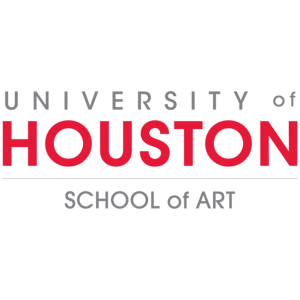100 Fine Arts Building
Houston, Texas 77204
United States
T +1 713 743 0867
cota@uh.edu
The University of Houston School of Art is proud to announce its spring 2022 visiting speaker series featuring practitioners and thinkers at the forefront of contemporary art, criticism and design. Distinguished guests offer a diverse range of perspectives on the most pertinent issues facing today’s makers and scholars. The series is a key component of students’ experience at the School of Art. In addition to presenting their work to a large audience of students and community members, speakers spend extended periods engaging directly with students in small gatherings for focused debate and conversation, in formats tailored to their individual practice. Past enagements have included hands-on workshops, master classes, studio visits, demonstrations, and interactive performances. Recent guests include Derrick Adams, Charlene Villaseñor Black, Aruna D’Souza, Beverly Fishman, Coco Fusco, Nicholas Galanin, Julia Geurnsey, Jeffrey Gibson, Lisa E. Harris, Rob Hopkins, Candace Lin, Miwa Matreyek, De Nichols, David Rokeby, RaMell Ross, Richard The, Margaret Wertheim and John Yau.
This spring we present these conversations both in person and online, welcoming audiences from the Houston community and across the globe. All lectures are free and open to the public and will be broadcast via Instagram Live, and/or Zoom. Check our website for connection information. An archive of past lectures is on our YouTube channel.
Ramón Tejada is a (New Yorkino / Afro-Caribbean / American) designer (as Estudio Ramón) and educator based in Providence, RI. He works in a hybrid design/teaching practice focusing on collaboration, inclusion, unearthing and the responsible expansion of design a practice he has named “puncturing.” Ramon is an Assistant Professor in the Graphic Design Department at RISD. He has spoken and/or led workshops at the Design Campus/ Kunstgewerbemuseum in Dresden, Germany, Pratt Institute, The New School/ Parsons, Mass/Art, RCA, CCA, CalArts, Otis, Cranbrook, Emily Carr University, OCAD University, SF Design Week, among others. He has been collaborating with Silas Munro on a series of workshops titled “Throwing the Bauhaus Under the Bus,” and with Polymode as curator and lead on the BIPOC Design History: Incomplete Latinx Stories of Diseño Gráfico.
Sama Alshaibi, Guggenheim Fellow and internationally renowned artist, makes art at the intersections of photography, performance and sculpture. In this lecture, she will discuss her performances that depict her body as a powerful feminized site resisting the pretext for subjection in the aftermath of war and migration.
Working between photography, video, and installation, Alshaibi (b. 1973, Iraq) links themes of dispossession, mobility, margins, refuge, entropy, and future/historic imaginings. Alshaibi’s performances depict her body as a powerful feminized site resisting the pretext for social subjection in the aftermath of war and migration. In 2021, Alshaibi was named a Guggenheim Fellow in Photography, and a recipient of the Phoenix Art Museum’s 2021 Arlene and Morton Scult Artist Award. She was also a recipient of a 2019 Artpace San Antonio residency and the 2018 Arab Fund for Arts & Culture Visual Arts Grant. Alshaibi’s exhibitions include the 55th Venice Biennale; State of the Art 2020 (Crystal Bridges Museum of Art); 2019 Cairo International Biennale; 2017 Honolulu Biennial; American University Museum, Washington D.C.; SMoCA; MARTa Herford Museum (Germany); Herbert F. Johnson Museum of Art (NY); MoMA (NY); Arab American National Museum (Michigan); Pen + Brush (NYC); Institut Du Monde Arabe (Paris); and Ayyam Gallery (UK/UAE). Her monograph, Sama Alshaibi: Sand Rushes In (New York: Aperture, 2015), features her Silsila series. Alshaibi is Professor of Photography, Video and Imaging at the University of Arizona in Tucson.
Rubén Ortiz-Torres was born in Mexico City in 1964. Educated within the utopian models of republican Spanish anarchism soon confronted the tragedies and cultural clashes of post colonial third world. Being the son of a couple of Latin American folklore musicians he soon identified more with the noises of urban punk music. After giving up the dream of playing baseball in the major leagues, and some architecture training (Harvard Graduate School of Design) he decided to study art. He went first to the oldest and one of the most academic art schools of the Americas (the Academy of San Carlos in Mexico City) and later to one of the newest and more experimental (CalArts in Valencia CA). After enduring Mexico City’s earthquake and pollution he moved to Los Angeles with a Fulbright grant to survive riots, fires, floods, more earthquakes, and proposition 187. During all this he has been able to produce artwork in the form of paintings, photographs, objects, installations, videos, films, customized machines, curatorial projects and even an opera. He is part of the permanent Faculty of the University of California in San Diego. He has participated in several international exhibitions and film festivals. His work is in the collections of The Museum of Modern Art in New York, The Metropolitan Museum of Art in New York, The Museum of Contemporary Art in Los Angeles, the Los Angeles County Museum of Art, Artpace in San Antonio, the California Museum of Photography in Riverside CA, the Centro Cultural de Arte Contemporaneo in Mexico City and the Museo Nacional Centro de Arte Reina Sofía in Madrid Spain among others. After showing his work and teaching art around the world, he now realizes that his dad’s music was in fact better than most rock’n roll.
At the UH School of Art, we celebrate the centrality of art and design as drivers of culture and recognize their importance to the vitality of a civil society. We train artists, designers, and art historians who will inform, engage and move us toward a better understanding of each other and the communities we inhabit. We do this by making a commitment to connect the creativity of art to the practice of global citizenship, equipping our students with strategies for making and tools for living that value diverse human expression, ethics and social engagement.


